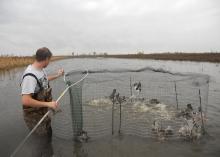Waterfowl backpack study tracks mallard migration
STARKVILLE, Miss. -- Hunters and birders in Mississippi who spot ducks wearing backpacks in the next five years do not need to get their eyes checked.
A new Mississippi State University Extension Service waterfowl study aims to arm landowners with practical habitat management recommendations that will support mallard populations in the Southeast. MSU Extension is teaming with the Mississippi Department of Wildlife, Fisheries and Parks, or MDWFP, to track the movements and migration patterns of female mallards for the research.
Leading the study is MSU Extension Instructor James Callicutt, who specializes in waterfowl and wetlands ecology. He said the work should provide valuable insights into how mallards use the north Mississippi Delta landscape by detailing the types of wetlands they frequent, their feeding and resting patterns and any preferences they show for certain wetland types.
“We’ll be able to track how their habitat use changes throughout the winter and examine how factors like weather, hunting pressure and habitat availability influence their movements and habitat use,” he said. “By visiting key locations used by the mallards, we can also measure habitat structure and composition to see if specific characteristics attract more mallard use.”
An emphasis of the study is early migrant mallards. Interest in mallards arriving in the Delta in October and November is growing due to concerns about the impacts of climate change on migration patterns, Callicutt said. The breeding origins of these birds are also uncertain and can possibly involve introgression, or the transfer of genes between two different species.
“If these birds are breeding in areas with risk of game-farm or urban mallard genetic introgression, this could impact the number of mallards present in the Delta during the early weeks of the hunting season,” he said. “Our focus on females is because they are less susceptible to harvest, as hunters tend to target drakes, and because studying hens provides key insights into population dynamics and reproductive success, as their behavior, survival and habitat use are crucial factors.”
The process of trapping the ducks began this year with a pilot phase. MSU researchers and technicians along with MDWFP staff will assist with the trapping and tagging of mallards throughout the study. Transmitters will be affixed in October and November to capture data on early migrant mallards. Some marking may also occur during and after the hunting season to gather additional information on mallard behavior and habitat use.
Callicutt expects the research to be fully underway by the winter of 2025-26, with plans to continue marking birds through the 2027-28 winter. His team plans to transmit 50 hen mallards per year over a three- to four-year period. The taggers will be affixing transmitters exclusively to females, he said, but individuals of any duck species will be banded if captured during trapping.
“We’ll use baited swim-in traps before the waterfowl hunting season to capture the birds. Female mallards that meet the criteria for transmitting will be outfitted with backpack GPS transmitters equipped with onboard accelerometers and solar panel chargers,” Callicutt said. “The accelerometers will give us behavioral data, indicating whether a bird is feeding, resting or in flight, while the solar panels charge the battery. These transmitters will send location data at intervals we select, which will likely be every hour during winter and once a day or every other day during spring migration and the breeding season.”
Ducks will be monitored until they experience mortality, battery depletion, or other transmitter malfunctions. If none of these issues occur, researchers could receive data for up to three years.
Houston Havens, MDWFP waterfowl program coordinator, said he hopes project findings will shed light on where ducks spend their time while wintering in the Mississippi Delta.
“This information could provide management insight into the types of wetlands needed on public and private lands, as well as how ducks respond to pressure and environmental factors like weather,” Havens said. “This information will be interesting to pair with our observations from aerial waterfowl surveys.”









